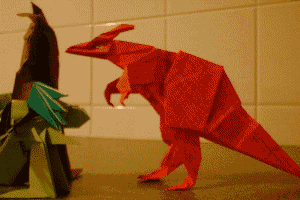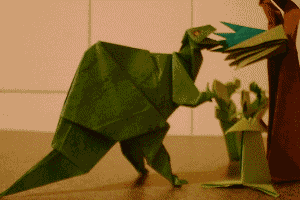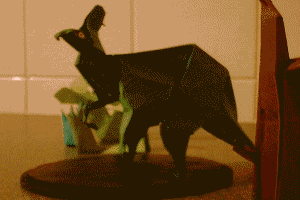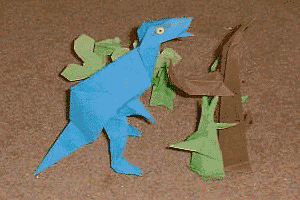Ornithopoda
Ornithopoda is one of the most diverse groups, including 70+ species of plant-eaters. They were present all over the planet. They include Iguanadontidae, and Hadrousauridae, which included all of the duck-billed and crested dinosaurs. Several other families exist.
SaurolophusSAWR-oh-LOAF-us(ridged reptile) Dr B. Brown (1912) Asia (Also North America) Cretaceous 9-12m |

|
| Saurolophus was an advanced crested duck-billed dinosaur. It had a large crest running backwards, which emerged as a tubular spike at the back of the skull. This structure was hollow and combined with loose skin at the top of its snout, it could have produced a huge bellow. The Asia species had a much longer spine, this is the one shown above. As in other duckbills, the front of the jaws had no teeth. Plant food was grasped bewteen the horn-covered duck bills at the front, and pulled back to be chewed by its many grinding teeth. |
Difficulty ***
|
Iguanadonig-WA-no-don(iguana tooth) Dr G.A. Mantell (1825) Africa, Asia, Europe Cretaceous 10m |

|
| Iguanadon was the second dinosaur to be named, after Megalosaurus. It was a widespread herbivore found over most of the planet. It had strong hind limbs with three big toes, each with a hard hoof-like nail. The hand had four long fingers and a spike like thumb. The tail was flattened and stiff and Iguanadon could have run well on its hind legs or walked on all fours. There were no teeth at the front of the jaw - only a bony beak. The cheek teeth were strong and ridged and a long toungue probably helped it feed. |
Difficulty ***
|
LambeosaurusLAM-bee-oh-SAW-rus(Lambe's reptile) Dr W. Parks (1923) North America Cretaceous 15m |

|
| Lambeosaurus was a crested duck billed dinosaur with a square shaped crest pointing forwards and a long spine pointing backwards. The nostrils ran up from the snout and through the crest, so that the whole thing was hollow. It may have been used for a huge bellow. Lambeosaurus was big (15m long) and its bones are massive. |
Difficulty ***
|
Anatosaurusan-AT-oh-SAW-rus(duck reptile) Dr R.S. Lull & Dr N.E. Wright (1942) North America Cretaceous 10-13m |

|
| Anatosaurus was a classic 'duck-pilled' dinosaur. It had a low skull without a crest and a broad snout. This was a widespread herbivorous dinosaur with several different species. Parts of skin have been preserved and this suggests that the digits of the limbs were webbed, and may have been useful for swimming. |
Difficulty ***
|